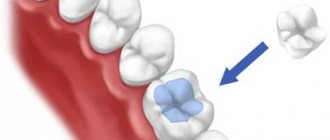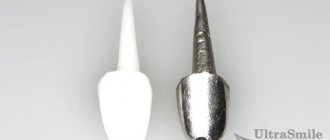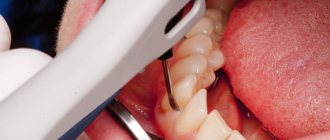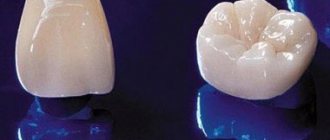What it is
A stump inlay is an indispensable item when restoring severely damaged teeth. There are cases when a patient comes to the dentist with a tooth broken at the root in such a state that it is easier to remove it and install an implant, but the patient’s will is the law, and if he wants to restore a tooth with almost complete absence of walls, the doctor can help in this difficult matter. stump pin inserts .
For quite a long time, before the advent of pins manufactured on an industrial scale, the treatment of this type of destruction was carried out using an individual approach.
A stump inlay is a structure specially made from an impression and fixed with a cementing composition into the pre-processed holes of the tooth being restored, onto which the dentist subsequently builds up the walls and crown.
Unlike pins, stump inlays are not installed on damaged teeth in one visit, and for many dentists, and even for patients themselves, this option is very inconvenient. And, nevertheless, their use guarantees that such a tooth will definitely never break or be susceptible to destruction, i.e. will last with the person for the rest of his life, and will not be limited to the warranty period, which is typical for ordinary pins.
The fact is that, unlike a pin, the stump insert redistributes the load on the entire tooth evenly , since it has support over the entire surface and is fixed in each root canal. Fastening with a cementitious composition ensures a completely tight fit to the remains of the tooth, which prevents the formation of microcracks into which food debris or liquid could get in, causing the development of caries.
Of course, the use of modern factory pins speeds up and reduces the cost of restoring a damaged tooth, which is sometimes beneficial for both the doctor and the patient, but at the same time the quality of the work suffers, which will not happen if your choice is a stump crown. Let's look at the main differences between pins and inlays.
Pros and cons of stump inlays
This method has many advantages. For example, the tab is fixed inside the canal much better than pins. The load on the teeth (especially chewing teeth) is uniform and natural. If you damage the crown, the inlay does not need to be replaced. They will simply make a new crown for you based on an existing impression.
Tabs are a universal solution. They can be used in cases of complex shape and obstruction of root canals. The product is cast, i.e. the crown and root parts will not split in half, and the upper part will not fall out. Disadvantages include prices and timing. Although the second point is controversial. Two visits within a week is, of course, longer than a one-time placement of a filling, but much faster than six months of suffering during implantation. Also, some people believe that to install such a tab, too much dentin has to be removed. But we all understand perfectly well that it is installed when there is significant destruction of the tooth crown, when other methods are not effective.
Are there any complications? Theoretically possible if the tab was placed in a tooth that was not pulpless. Its secondary caries and pulpitis are possible. Sometimes patients complain that their tooth hurts. If such symptoms occur, you should immediately consult a doctor for help. You may need to take a photo to determine what is causing your symptoms.
Stump tab or dental pin?
In recent years, it is very rare for a dentist to be faced with the question of what to choose to restore a damaged tooth, a core tab or a pin. It is believed that the choice of standard pins for the treatment of any degree of destruction is the most justified in terms of all possible indicators, but this is not the case.
The fact is that you can choose restoration with a pin only if the destruction of the walls does not exceed 40-50% of the total mass of the tooth, i.e. the use of a crown is not indicated for its treatment. To restore single-rooted teeth on which it is planned to install a crown, pins will also come in handy.
In other cases, namely in case of serious (more than 50%) tooth decay with two or more roots, pin-stump structures will be the only reasonable solution. The fact is that the pin-stump inlay is not only capable of providing the tooth being restored with high strength, but also guaranteeing the absence of further destruction throughout the rest of its life.
Pins also have their advantages. If you compare the characteristics of the stump tab with the pin, you get the following list:
| Stump tab | Dental pin |
| pros | pros |
|
|
| Minuses | Minuses |
|
|
Indications for the use of a core inlay made of zirconium dioxide
The main indications for using the method are the following factors:
- The need to install a “bridge”
- The need to strengthen the dental unit on which a crown is required,
- 2/3 of a tooth or more is destroyed.
In cases where the patient requires, for example, the installation of a bridge, but the dental units on which it is planned to be attached are severely damaged, the dentist may suggest the use of stump inlays. However, it is worth considering that, like other techniques, this one has some contraindications, in which the use of the technology is not recommended or completely contraindicated.
Treatment
Before starting restoration work, the doctor is obliged to check the tooth root for the presence of inflammation, purulent discharge, or cysts. The use of stump pin inlays is possible only if the root tissue is reliable and in the absence of any hint of an inflammatory process. The fact is that after correct installation of the structure, removal of the core tab is only possible together with the tooth itself.
The length of the root cannot be less than the height of the crown being installed, and the walls must be at least 1 mm thick so that they do not crack under pressure. The remaining walls are removed to a height of approximately 1-2 mm above the gum level, and the tooth is prepared for a stump inlay.
Before installation, the doctor files additional pins located on the top of the insert, making it easy to install. After fixation, they break off, and the surface of the inlay is polished. Various types of composite cements are used to fix the inlay in the root canals. The cementing substance is introduced into the channels, applied to the pins, after which the tab is inserted into the prepared holes and securely fixed. Preparations for crown installation are made during your next visit to the dentist.
What is known about the shortcomings
According to reviews from some patients, a zirconium inlay (restorative or stump) has only one drawback - its high cost. Another disadvantage is the time spent on prosthetics - it takes about 2 weeks to complete the treatment. Although, for example, CEREC technology allows you to make a restorative microprosthesis in 15-20 minutes - and it will be installed on the day you go to the clinic. However, such equipment is not available everywhere.
Read on the topic: what is CEREC technology - when does the dentist and patient need it, its pros and cons.
Another disadvantage is the pure white color of zirconium dioxide (several shades lighter than natural enamel) and its opacity. But dental technicians solve this problem by applying liquid ceramic, colored in the shade of enamel, to the upper part of the zirconium restorative microprosthesis. Or you can use alternative prosthetic options (more on them below).
Molded tab
In modern dental practice, cast stump pins are used much more often than collapsible ones, since their manufacture and installation are much simpler than the latter. Such an insert usually consists of a main platform that restores a defective tooth, and fixing pins that ensure reliable fastening of the entire structure in the tooth canals.
A cast stump inlay implies monolithically interconnected parts, the separation of which during installation or further use is impossible. Most often, such structures are used to restore single-rooted teeth, as well as double-rooted teeth with non-parallel canals. Using a solid inlay in teeth with three and four canals is extremely problematic.
How are dentures made and installed?
The processes of preparation for prosthetics, creation of a zirconium dioxide microprosthesis and its fixation consist of the following stages:
- Stage 1 – diagnosis: also at this stage, contraindications are excluded, the condition of the tooth itself, as well as neighboring and opposite ones, is studied,
- Stage 2 – preparation: the dentist-therapist removes all carious tissues, if necessary, depulps the tooth and fills the root canals, leaves a cavity for a classic restorative inlay or forms it inside the roots,
- Stage 3 – taking impressions (impressions): for example, using wax or silicone (this depends on the type of future prosthesis), the color of the restoration is selected. In clinics with modern equipment, digital impressions of the oral cavity can be made using an intraoral 3D scanner - this is fast, convenient and very accurate,
- Stage 4 – modeling: a real model of the prosthesis is created based on impressions in a dental laboratory, and a virtual model is created in a computer program based on digital impressions. But the real model will also need to be digitized and worked out in a CAD/CAM system for the next stage,
- Stage 5 – manufacturing: production occurs by milling on a machine, because the material is so strong that it will not be possible to create a prosthesis by hand. Usually the workpiece is made 20-25% larger than the actual size, because After milling, it is baked - in this case, the material “shrinks” to the required parameters. If necessary, the microprosthesis is covered with a layer of colored ceramics. Next, the product is sent to an orthopedic dentist,
- Stage 6 – fixation of the zirconium inlay into the patient’s tooth.
Collapsible stump tab
Since it is impossible to insert a cast inlay into a root with three or four channels without damaging the tooth tissue, there is a need to manufacture a collapsible structure. After taking an impression of the tooth, the inlay maker must determine which pins move freely into and out of the canals, and which will have to be removable due to their location at an angle to the bulk of the inlay or the central pins.
When properly manufactured and installed, a collapsible stump tab is not much different from a cast one. It fits perfectly to the shape of the tooth, leaving no gaps or gaps due to the ease of insertion into the canals. Once installed, it is simply impossible to remove such an insert from the tooth, since all the pins are located in the root at different angles, which is why it will have a lifetime warranty.
How much does a crown inlay cost?
Before treatment, you should familiarize yourself with its cost. How much a particular tooth tab costs depends on several factors:
- Type of tab.
- Manufacturing material.
- Number of roots.
- Manufacturing method.
- Dental laboratory equipment.
- Experience and qualifications of a specialist.
- Prestige of the dental clinic.
In Moscow, a single-root metal insert in a tooth costs about two thousand rubles, and a double-root one costs about three thousand rubles. Ceramic products cost over ten thousand rubles, and a zirconium structure will cost more than fifteen thousand rubles. Gold designs also have a high cost.
Manufacturing
The process of making inserts is not as simple as it might seem at first glance. First, the doctor must prepare the remaining living tooth tissue for taking an impression. If necessary, the canals are sharpened until they are parallel, and the inside of the tooth is treated with Vaseline. Special plastic for modeling is diluted to a liquid state, poured into a syringe and carefully inserted into the channels and onto the internal walls, then ashless pins are inserted into the channels.
To create a model of an inlay of the required size, the tooth is limited to a special matrix, along the height of which quick-drying plastic is added. When the plastic hardens, the tab is carefully removed from the tooth. The doctor’s main task at this stage is not to damage the model, since plastic is a very capricious material.
The doctor should check the finished model for defects and pores and eliminate them if possible. If elimination is not possible, it is better to redo the model again. After removing the inlay, the tooth canals should be disinfected and a temporary filling should be placed, and the finished model should be handed over to a dental technician to make a core crown. The manufacture of core inlays for 2-3-root teeth with parallel canals is not very different from single-canal ones, but if the canals are not parallel, the manufacture of a cast or collapsible structure depends on the position of the tooth.
Structure, functions and advantages
The inlay consists of a stump and processes that are fixed in the canals. It is made by a dental technician using an individual impression. The design is small and inexpensive, but a very necessary product for high-quality dental treatment and prosthetics.
Photo of a dental inlay for a crown
Design features:
- Strengthening root canals and hard tissues.
- Creation of a stump for fixation of crowns or dentures.
- Correct distribution of chewing pressure.
- Restoration of the physiological functions of the tooth.
Indications
Tooth restoration with an inlay is carried out after endodontic treatment of the root canal system , that is, after elimination of pulpitis or periodontitis. With these diseases, tooth tissue is destroyed, often the crown is completely destroyed. To restore a tooth, prosthetics with a crown is necessary, and the crown must be installed on the stump of the tooth. When the natural stump is preserved, the crown is installed immediately. In the absence of one, it is necessary to create a support, so first a stump inlay is made.
Photo of the installed core inlay for the crown
Indications for the manufacture of the structure:
- significant tooth decay;
- absence of a coronal part;
- one or two thin walls of the tooth;
- the need to manufacture a bridge with support;
- large and wide tooth canal.
Contraindications
Installation of a core inlay under a crown is not recommended in the following cases:
- poor-quality root canal treatment;
- root damage;
- chronic inflammatory processes in periodontal tissues;
- tooth mobility;
- periodontitis, periodontal disease;
- allergic reaction to the structure.
Advantages and disadvantages
In the field of dentistry, core inlays are very important structures. With their help, you can save teeth from which only the root remains. Disadvantages include higher cost compared to standard pins and the fact that the manufacturing process requires several visits to the doctor.
The products have many advantages:
- the ability to restore even severely damaged teeth;
- fixation with dental cements prevents the development of caries and other dental diseases;
- the root is strengthened;
- chewing pressure is distributed evenly;
- reliable fixation is ensured;
- high strength;
- the crown can be replaced without removing the tab;
- wide selection of materials for manufacturing;
- long service life;
- low cost.
Which material to choose
The selected material for making the inlay must meet a number of requirements: be hard and elastic, bioinert, shrink to a minimum during casting, and have low thermal conductivity.
Modern dentistry can offer the following options:
| Ceramic | Best suited for patients who prefer non-metallic crowns. Such inlays are also called cosmopost and are most often used to restore front teeth. The color of the inlay itself can be perfectly matched to the natural color of the tooth. For manufacturing, zirconium or carbon pins are used, onto which a ceramic crown is subsequently built up. There is also a mixed option - a stump inlay with metal-ceramics, it is much stronger than ordinary ceramic, so it can be freely used on teeth that perform the chewing function. |
| KHS (cobalt chromium) | Ideal for restoring chewing teeth that bear heavy loads is a cobalt-chrome core inlay. Such inserts are distinguished by high hardness and strength, but they are difficult to process, so the KHS insert is not suitable for a collapsible design. Moreover, the alloy of cobalt and chromium may cause an allergic reaction in some patients. |
| From gold | The safest, most aesthetic and hypoallergenic are gold stump inlays. Gold is a universal material that does not enter into chemical reactions, so products made from it are not subject to corrosion and destruction; moreover, it is more convenient to work with gold, since this metal is easy to melt, forge and post-installation processing. |
| Metal | Among metal stump inlays, inserts made of noble (silver, palladium) and non-precious (titanium, steel, cobalt, nickel, chromium) alloys are popular. The advantage of silver is its bactericidal properties, however, after installing a silver alloy insert, an oxide film begins to form around the tooth and on its surface, causing darkening of the enamel and pigmentation of the gum tissue. Titanium has the highest bioinert properties and high hardness, but it is not very convenient to work with due to its fragility. And the alloy of chromium and nickel is subject to severe shrinkage. |
In any case, if you decide to restore a damaged tooth using an inlay, rather than using standard factory pins, discuss your decision with your doctor in advance and get detailed advice on this issue.
What are the benefits of tabs?
The advantages of inlays are a consequence of the method of their manufacture - by a technician in a laboratory using a model of the patient's jaws, with sufficient time and the ability to accurately simulate the final result. This approach allows us to take into account many more factors necessary when replacing lost tooth tissue. This technique allows:
- increase the accuracy of the replacement of lost tooth tissues and completely restore both the contact between adjacent teeth (contact points) and the correspondence of the cusps between the teeth of the upper and lower jaws (occlusal relationships) - this completely restores the function of the tooth;
- use materials that have better properties than composites. For example, the composite is characterized by shrinkage (decrease in volume), which leads to the formation of space between the filling and tooth tissue and the penetration of microorganisms, and then to caries in this space. The abrasion of the composite is on average 4 times greater than the abrasion of tooth enamel. The abrasion of ceramics (the material from which it is preferable to make inlays) almost corresponds to the abrasion of tooth enamel.
The combination of these factors ensures a longer service life and better aesthetics of restoration using inlays compared to filling materials.









